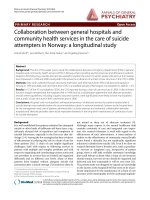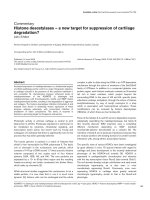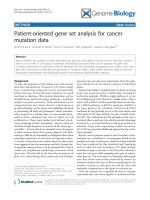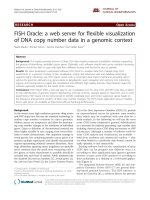Luận Án TS Y học: Patient satisfaction a strategic tool for health services management
Bạn đang xem bản rút gọn của tài liệu. Xem và tải ngay bản đầy đủ của tài liệu tại đây (447.31 KB, 98 trang )
Patient satisfaction: a strategic tool
for health services management
Thesis presented
by
Anna Maria Murante
to
The Class of Social Sciences
for the degree of
Doctor of Philosophy
in the subject of
Management, competitiveness and development
Tutor: Prof.ssa Sabina Nuti
Advisors: Prof. Adalsteinn D. Brown and Prof. Renato Fiocca
Scuola Superiore Sant’Anna
A.Y. 2009-2010
2
3
CONTENTS
Acknowledgements 5
INTRODUCTION 7
CHAPTER 1 – The theoretical framework 13
1.1 The patient role 13
1.2 Patient satisfaction: a complex concept 14
1.3 The patient satisfaction measurement 15
1.4 Patient experience: a new perspective for performance evaluation systems in
health sector 16
References 21
CHAPTER 2 - Tools and methods to measure patient experience for the
multidimensional performance evaluation systems in the health sector. 27
2.1 – Introduction 31
2.2 – The theoretical framework 31
2.3 – Methodology 33
Survey 35
Sampling frame 35
Questionnaire 35
Interviews 38
2.4 – Results 39
Participants 39
Validation process 40
A) Factor Analysis 41
B) Cronbach’s alpha 43
C) Inter-correlation analysis 43
D) Overall evaluation and its dimensions 44
2.5 – Discussion 45
2.6 – Conclusion 47
References 49
CHAPTER 3 - The effects of institutional characteristics on inpatient
satisfaction. A multilevel analysis. 53
3.1 – Introduction 55
3.2 – Objectives 56
4
3.3 – Data and Methodology 57
Survey 57
Questionnaire 57
3.4 – Multilevel Analysis 59
Explanatory variables, patient level 61
Explanatory variables, hospital level 62
3.5 – Results 64
Descriptive analysis 64
Multilevel model results 64
3.6 – Discussion and Conclusion 69
References 72
CHAPTHER 4 - A marketing approach for creating patient oriented pathways
in hospital services. 75
3.1 – Introduction and Objectives 77
3.2 – Literature review 77
Health care services 77
Patient satisfaction 78
3.3 –Methodology 79
Setting 79
Survey 81
Statistical analysis 83
3.4 – Results 83
Descriptive statistics 83
Multivariate linear regression model 84
3.5 – Discussion 87
3.6 – Managerial implications 88
3.7 - Limitations and further research 89
References 90
CONCLUSION 95
5
Acknowledgements
This thesis is the result of the research work carried out in cooperation and with the
support of the whole team of Laboratorio Management e Sanità of Scuola Superiore
Sant’Anna in Pisa. In particular, I would like to thank: my supervisor, Professor
Sabina Nuti, a “volcano of ideas”, for continuously stimulating me and posing
challenging questions in our research activities; Chiara Seghieri for patiently guiding
me through the fundamentals of statistics; and all my colleagues for facing everyday
challenges together.
I wish to thank Professor Adalsteinn Brown for his precious suggestions and for the
opportunity he gave me to carry out a part of the analyses described in this work in
the Health System Strategy Division of the Ministry of Health and Long-Term Care
in Ontario.
A sincere thank to Professor Renato Fiocca, for taking care of the students
education and their future. I am grateful to him for devoting his valuable time to
read my thesis and for his careful and wise advice.
Furthermore, I am indebted to all citizens who accepted to be interviewed and
provided us with a wealth of information on the quality of health services and to all
professionals of Health Authorities who made the surveys possible.
This thesis would not have been possible without the support of all my family, and
in particular without the precious example of my mum and dad who taught me to
work hardly in order to achieve important goals.
The greatest thanks are for Luigi, for his love and warm encouragements in any
situation!
6
7
INTRODUCTION
This doctoral thesis focuses on the role of patient satisfaction in health services
management as a strategic measure of health organizations’ performance. Most of
the literature contributions on patient satisfaction were developed in US and UK;
however, in the last years also Italian researchers and health managers have
increased the interest and attention for the patient perspective.
In detail, this work mostly refers to the patient experience surveys systematically
conducted in Tuscany Region and used to create indicators included in the Tuscan
Performance Evaluation System. Since 2004 this system, developed by Laboratorio
Management e Sanità of Scuola Superiore Sant’Anna, has been monitoring the
results achieved by Tuscan Health Authorities considering also indicators on patient
satisfaction .
In this no profit – based scenario, the patient satisfaction surveys are valuable data
sources to improve patient health and service quality. To better meet the patients’
needs and to achieve the main goals of a public health care system, the determinants
of patient satisfaction and their changes across organizations have to be investigated.
Research questions
Based on these premises, the three articles that constitute the main body of this
thesis aim to respond to the three research questions (RQs) hereafter presented.
RQ1. Which are the dimensions that can explain patient satisfaction’s concept?
The complex nature of patient satisfaction’s concept implies that dimensions to be
investigated are well identified considering the patient perspective. In fact, a critical
aspect in the patient satisfaction’s measurement is that models and instruments
sometimes reflect the providers’ perspective rather than the patients’ one (Calnan,
1988). Thus, in order to monitor patient satisfaction with a health service by using
questionnaires it is not enough to identify the main aspects of care and to define
questions related to them. On the opposite side, it is important to use appropriate and
scientifically rigorous means to measure patient experience so that accurate and
meaningful information is produced.
A common objection to patient satisfaction research is related to technical and
methodological issues (Rubin, 1990; McDaniel and Nash,1990). In 1990s, when
8
patient satisfaction measures were increasingly used to monitor the performance of
health services, Sitzia (1999) pointed out the poor attention to the validity and
reliability properties of questionnaires adopted in previous studies. These properties
explain the extent to which a questionnaire is really able to capture the construct it is
supposed to measure (Streiner et al, 2008). When the questionnaire properties are
not evaluated and methodological weaknesses exist, misleading results may be
generated and erroneous signals may be sent out. Thus, a rigorous methodology has
to be ensured.
On the basis of the above considerations, the first paper (Murante A.M., Strumenti e
metodi per misurare la patient satisfaction nei sistemi multidimensionali di
valutazione della performance in sanità, presented at AIES Conference, Bergamo,
2009) aims at analyzing the validity and reliability properties of a questionnaire used
by the Regional Health Care Service (RHCS) of Liguria and then by the RHCS of
Tuscany, Umbria, Val d’Aosta and Trento to measure citizens experience with
primary care services. The validation process of the questionnaire allowed to
identify the main dimensions that can explain the overall patient satisfaction with
primary care.
RQ2. Which are the personal and organizational characteristics that better
explain the variability of patient satisfaction?
A large number of studies analyzed how the patients’ perception of health services’
quality is influenced by their expectations, socio-demographic characteristics and
clinical needs (Westaway, 2003; Bruster et al., 1994; Sitzia and Wood, 1997).
Moreover, in recent years, the characteristics of the external environment have been
also considered as additional factors influencing individual evaluation. Researchers
mainly observed whether variations exist across different organizations (e.g.
hospitals) (Stubble et al, 2007) (Kollen et al, 2010) and which their origins are
(Veenstra et al, 2003; Brown et al, 2008; Hekkert et al, 2009; Salisbury et al, 2010;
Van Empel et al, 2010). A combined analysis of both individual and contextual
characteristics allows to take into account the main aspects influencing overall
satisfaction. Furthermore, adjusting for these aspects, patients’ ratings can also be
compared across organizations.
The second paper (Murante A.M., Seghieri C., Nuti S., Brown A.D., The effects of
institutional characteristics on inpatient satisfaction. A multilevel analysis,
proceeding) focuses on the multidimensionality of the health quality concept. As
9
pointed out by Donabedian (Donabedian, 1988) structural and organizational
aspects, healthcare process and patient satisfaction have to be considered together
according to a comprehensive approach. The paper describes the results obtained
using a multilevel model in order to investigate: (i) which are the personal (level 1)
and organizational (level 2) characteristics that more affect patients’ experience with
Tuscan hospitals and (ii) how much of the overall variability is explained at each
level. Investigating the variation of satisfaction within and between hospitals and its
origins provides valuable information for planning effective policies of quality
improvement. In fact, depending on whether patient experience is more influenced
by patient or hospital characteristics, different actions have to be defined and
implemented.
RQ3. Which are the elements to be considered in order to create patient -
oriented services?
In the last years health systems changed the way of thinking and delivering care:
patient became the centre of the overall care process and new organizational models
were applied in order to provide patient-centered services. The publication Seeing
the person in the patient (Goodrich and Cornwell, 2008) provides several definitions
of the “patient-centered care” concept, of which the most complete and clear one
identifies the following dimensions: “(i) compassion, empathy and responsiveness to
needs, values and expressed preferences; (ii) co-ordination and integration; (iii)
information, communication and education; (iv) physical comfort; (v) emotional
support, relieving fear and anxiety; (vi) involvement of family and friends” (Institute
of Medicine, 2001). This definition is consistent with the responsiveness’s goal
assigned to the international health systems by the World Health Organization. In
fact, health services have to meet the clinical needs of population as well as to
ensure respect for persons, prompt attention, quality of amenities, access to social
support networks and choice of the provider.
Based on these premises, the third paper (Murante A.M., Nuti S., A marketing
approach for creating patient oriented pathways in hospital services, accepted at the
10th International Marketing Trends Conference, Paris, January 2011) aims at
promoting marketing’s approaches and methods in order to orient health policies
towards the actual needs of citizens. The study focuses on the elements that most
affect the patient’s overall experience and the factors to be improved in order to
create patient-centered hospital service. The analysis highlights also the differences
10
existing among patients hospitalized in three different wards (medical, surgical and
obstetrical, gynecological and pediatric).
11
REFERENCES – Introduction
Brown A.D., Sandoval G.A., Murray M. (2008), Comparing patient reports about
hospital care across a Canadian – US border, International Journal for quality in
Health Care; Vol. 20 (2): pp. 95 – 104.
Bruster S, Jarman B, Bosanquet N, Weston D, Erens R, Delblanco T. (1994),
National survey of hospital patients. BMJ;309:1542–6.
Calnan M., Towards a conceptual framework of lay evaluation of health care. Soc
Sci Med 1988;27:927–33.
Donabedian A. (1988), Quality assessment and assurance: unity of purpose,
diversity of means. Inquiry;25:173-192.
Hekkert K.D., Cihangir S., Kleefstra S.M., Van den Berg B., Kool R.B. (2009),
Patient satisfaction revisited: a multilevel approach. Social Science & Medicine;
69:68-75.
Institute of Medicine (2001). Crossing the Quality Chasm: A new health system for
the 21st century. Washington DC: National Academy Press.
Kollen B. J., Groenier K.H., Berendsen A. J. (2010), Patients’experiences with
continuum of care across hospitals. A multilevel analysis of Consumer Quality
Index Continuum of Care. Patient Educ Couns 2010, doi: 10.1016/j.pec.2010.04.035
McDaniel C., Nash J.G., Compendium of instrument measuring patient satisfaction
with nursing care. Qual Rev Bull 1990: 16: 182 – 188.
Rubin H.R., Can Patient evaluate the quality of hospital care? Med Care Rev 1990:
47: 267 – 326.
Salisbury C., Wallace M., Montgomery A.A. (2010), Patients’ experience and
satisfaction in primary care: secondary analysis using multilevel modeling. BMJ;
341: c5004, doi:10.1136/bmj.c5004.
Sitzia J., How valid and reliable are patient satisfaction data? An analysis of 195
studies. International Journal for Quality in Health Care 1999: 11 (4): 319-328.
Sitzia J., Wood N. (1997), Patient satisfaction: a review of issues and concept, Soc
Sci Med; Vol. 45 (12): 1829 - 1843
Streiner D.L., Norman G.R. (2008), Health Measurement Scales: a Practical Guide
to their Development and Use, 4th edition. Oxford: Oxford University Press.
12
Stubbe J.H., Brouwe W., Delnoij D.M.J. (2007), Patients’ experiences with quality
of hospital care: the Consumer Quality Index Cataract Questionnaire. BMC
Ophthalmology, 7:14, doi: 10.1186/1471-2415-7-14
Van Empel I.W.H, Hermens R.P.M.G., Akkermans R.P., Hollander K.W.P., Nelen
W.L.D.M., Kremer J.A.M. (2010), Organizational determinants of patient-centered
fertility care: a multilevel analysis. Fertility and Sterility.
Veenstra M., Hofoss D. (2003), Patient experience with information in a Hospital
setting. A multilevel approach. Medical Care; Vol. 41 (4): 490 – 499.
Westaway M. S., Rheeder P., Van Zyl D. G., Seager J. R. (2003), Interpersonal and
organizational dimensions of patient satisfaction: the moderating effects of health
status. International Journal for Quality in Health, Vol. 15 (4): 337 – 344.
13
CHAPTER 1
The theoretical framework
Before proceeding with the complete presentation of the three research’s papers, this
first chapter introduces an overview of patient satisfaction literature with a focus on:
(i) the patient role; (ii) the patient satisfaction’s concept, its subjective nature and its
determinants; (iii) the use of patient satisfaction measures as outcome and process
indicators; (iv) the introduction of patient perspective in multidimensional systems
for evaluating the performance of health organizations. All these issues are the basis
of the patient experience and satisfaction research field and constitute the framework
of this PhD thesis.
1. The patient role
Usually, words as patient, user and consumer are indistinctly used as synonyms,
even though they differ for the nature of relationships between health professionals
and citizens. While the patient is a person who has an illness and comes to doctors
and nurses asking for advice and treatment, the user may identify people who used,
use or could use health care services. Instead, the consumer reminds us of a person
who purchases goods and services for his needs or a person who consumes
something (Herxheimer and Goodare, 1999). According to McIver (1992) in 1980s a
general shift towards consumerism, evident in UK National Health System,
increased the promotion of a “customer service-oriented culture”. Thus, even though
the use of “consumer” concept in health care mainly received a wide opposition
from the medical establishment (Wassersug, 1986) because of its strong commercial
connotation (Blaxter, 1995; Leavy et al 1989, Normand, 1991), the consumerism
movement introduced in health systems the issue of the protection of the consumers’
interests. Patient becomes a consumer when he looks for health services after having
collected all information helpful to make the best choice (Shackley and Ryan, 1994).
In this regard, researchers questioned: Can patient fulfil the role of consumer? and
more, Does patient wish to fulfil it? (Owens and Batchelor, 1996). In 2002 a study
conducted in eight European countries (Germany, Italy, Poland, Slovenia, Spain,
Sweden, Switzerland and UK) highlighted that patients ask for a more autonomous
role in the health care decision-making process and, then, for more information,
14
equitable access, freedom of choice, prompt attention, respect and quality of
amenities (Coulter and Jenkinson, 2005).
Nonetheless, consumers of health care still are often not well and sufficiently
informed. This information asymmetry causes an imbalance in the relationship
between who asks for health services and who provides them. Even though much
effort has been put into these issues, the Health Care Systems still have to work in
order to move away from the idea of patient as a passive and dependent stakeholder.
2. Patient satisfaction: a complex concept
In 1990s researchers, health policy-makers and managers gave more attention to the
patient perception of the quality of health services (Behm et al., 2000). In these
years, the patient satisfaction studies have increased as shown by a PubMed search
for “patient satisfaction” or “customer satisfaction” (Figure 1).
Figure 1 - Results of a PubMed search for “Patient satisfaction” or “Customer
satisfaction” concepts (1950 – 2010).
Despite its large use, the patient satisfaction was initially considered as a difficult
concept to be measured and interpreted (Fitzpatrick & Hopkins, 1983; Williams,
1994). An unanimous consensus on the definition of satisfaction with healthcare is
not already fully achieved (Avis et al, 1996; Baker, 1997) due to the
multidimensional and subjective nature of this concept, which is affected by
individuals’ expectations, needs or desires. For example, when users have limited
knowledge of opportunities and low expectations of service quality, high satisfaction
scores may be recorded even though poor standards of care have been ensured.
Factors influencing dissatisfaction could be somewhat different from factors
generating satisfaction. While on one side an adequate or acceptable standard of
15
quality might be considered as necessary, on the other, a feeling of satisfaction
might result from an high quality service.
Moreover, when something negative happens consumers might be satisfied or not;
for instance, this depends on whether the negative event is caused by the health
professionals or it is not due to their behavior (Williams et al, 1998).
Thus, it is possible that what makes one person satisfied might make another one
dissatisfied (Avis et al, 1996; Greeneich, 1993).
These ambiguities related to the “patient satisfaction” concept enhance the debate
among researchers, health professionals and managers. In recent years, new
approaches have also been evaluated and adopted in order to introduce more
objective measures of the service’s quality. For instance, researchers ask people to
report in detail their experience with health service using reporting and rating scales.
The obtained results could be considered more helpful in order to identify
weaknesses in the delivery and organization of the health services (Jenkinson et al,
2002). Sometimes, also patients’ willingness to use again and/or recommend
services (e.g., hospital, general practitioner, etc.) is investigated as a reliable proxy
of overall evaluation both in not for profit and in market-based health systems.
3. Patient satisfaction measurement
A critical aspect in the patient satisfaction’s measurement is that models and
instruments sometimes reflect the providers’ perspective rather than the patients’
one (Calnan, 1988). For example, the patient capability to evaluate health services
and professionals’ skills is frequently questioned (Ben-Sira, 1976; Rao et al, 2006),
even when these items receive high satisfaction rates. According to Hopkins et al.
(1994) patients are less capable of judging technical competence because of a real
informative asymmetry and in any case they are more reserved in expressing critical
comments with regard to the abilities of doctors. As a consequence, the high
satisfaction scores observed may depend on the confidence in doctors’ capabilities.
Instead, Coulter (2006) argued that well designed questionnaires allow to assess
both the technical competence and interpersonal skills of health professionals.
The patient satisfaction measurements have been generally used in order to provide
researchers, health managers and professionals with valuable information for
understanding patients’ experience, promoting patient’s compliance with treatment,
identifying the weaknesses in services and evaluating health service performance
(Fitzpatrick, 1984; Sitzia and Wood, 1997).
16
Although the debate on the use of patient satisfaction as an outcome measure is still
open (Reker et al, 2002; Norquist, 2009), it has been observed that satisfied patients
are more compliant and more likely to participate in their treatment (Stewart, 1989;
Guldvog, 1999). In fact, a satisfied patient is more aware of his care pathway and
more willing to follow the physician prescriptions.
As said before, the level of satisfaction depends on several and different elements.
For instance, healthy people tend to be more satisfied when they receive general
information on health services and on their quality; on the contrary, people with a
chronic condition may be more satisfied if involved in the decision-making process
(Cleary, 1997). Thus, the improvement of patient compliance requires to adopt
different actions depending on the patient’s profile.
The assessment of patient satisfaction with the process of care is an important
measure of the care quality and it allows to identify the phases of the process to be
improved. Questionnaires using report style questions allow to observe how the care
is delivered (Wensing et al, 2003; Leeper et al, 2003). Some studies have
highlighted that satisfaction strongly increases when care is provided in accordance
with the clinical standard procedures (Lantz et al, 2005; Marchisio et al, 2006).
Furthermore, the patients’ point of view may help managers to evaluate activities
such as the purchase of new technologies or the test of new medical treatments
(Hopkins et al, 1994; Goulrey and Duncan, 1998; Dunlop et al, 2003; Ahmad et al,
2008; Van Koulil et al, 2009).
4. Patient experience: a new perspective for performance evaluation systems in
health sector.
A famous statement on the performance–quality–management relationship argues:
“The ultimate goal is to manage quality. But you cannot manage it until you have a
way to measure it, and you cannot measure it until you can monitor it” (Eagle et al.,
1993). Thus, a question is: how to measure the quality in health care? In most cases,
managers and policy-makers who have approached performance measurement
agreed with Donabedian’s (1988) definition of health quality as a comprehensive
concept including both service characteristics (structure, organization, care process)
and patient satisfaction.
In the last years, several health care services have adopted multidimensional
evaluation systems in order to monitor the outcome of health programs (Katesa et
al., 2001) as well as the performance of organizations (Arah et al., 2003).
17
Table 1. Some examples of Systems of Performance Measurement in health sector adopting indicators on patient’s perspective.
Systems of Performance Measurement Indicators focused on Patient perspective Source
Ontario Hospital
Association (OHA), Canada, 1997
Patient Satisfaction
Ontario Hospital Association, Canada:
•
• www.hospitalreport.ca
Bridgeport Hospital, 2002 Hospital Consumer Assessments of Healthcare
Providers and Systems (HCAHPS)
•
/>dn=1
Duke University Hospital, 1998 Hospital Patient Satisfaction
•
/>asures/patient_satisfaction
Mayo Clinic, 2002 Hospital Consumer Assessment of Health
Plans Survey (HCAHPS)
•
Dutch health system, 2002 Consumer perspective
•
Sbroek et al, 2004
Performance Assessment Tool for Quality
Improvement in Hospitals (PATH), 2003
Patient centeredness
•
Veillard et al, 2005
• Groene , 2006
• Groene et al, 2008
COMPAQH, France, 2003 Patient satisfaction
•
Grenier-Sennelier et al, 2005
Joint Commission on
Accreditation of Health
Care Organisations
(JCAHO) (ORYX), USA, 1997
Patient centeredness The Joint Commission, USA.
•
•
• Groene et al, 2008
Reporting of hospitals performance in
Netherlands, 2003
Patient centeredness
•
Berg et al, 2005.
Verein Outcome, 2000,
Switzerland, 2000
Patient centeredness
•
Luthi et al, 2002
Performance assessment of the Tuscan
Health Services, 2004
Patient Satisfaction
•
Nuti, 2008
• Nuti et al, 2009
18
Patient perspective was also included in the performance evaluation frameworks
(Table 1) to observe whether organizations achieved all the three goals assigned to
them by the World Health Organization: (i) good health for the population, (ii) fair
payment systems and, last but not least, (iii) responsiveness to the public. Indicators
which consider patients’ perspective aim at monitoring whether health services meet
the overall needs of patients and are really patient-centred.
The Performance Evaluation System (PES) adopted by Tuscany Region (Italy) (Nuti
et al., 2009) is an example of a multidimensional approach of quality measurement
including indicators on patient experience. A brief introduction to the PES is
described below.
Tuscan Performance Evaluation System (PES) - In 2004 the Tuscan Health Care
System has introduced a multidimensional PES to assess results achieved by its
Health Authorities. The Tuscan Health Care System (THCS), that provides
assistance to about 3.700.000 citizens, is universal, publicly funded and managed
through a network of 12 local health authorities (LHAs) and five teaching hospitals
(one of them is a pediatric hospital). LHAs are responsible for providing care
services, from prevention to long-term care, including acute care, to the population
living in their area, while the five teaching hospitals provide high-complexity care.
35 public hospitals are available in Tuscany; 30 of them are managed by the 12
LHAs, while the remaining 5 are Teaching Hospitals (THs). In 2008, 614.450
discharges were recorded in Tuscan hospitals delivering about 95% of the regional
hospital care.
The PES, developed by Laboratorio Management e Sanità of Scuola Superiore
Sant'Anna in Pisa, is based on 50 measures, made up of 130 indicators, organized
into six dimensions: (a) Population health, (b) Regional policy targets, (c) Quality of
care, (d) Patient satisfaction, (e) Staff satisfaction, and (f) Efficiency and financial
performance (Nuti, 2008; Nuti et al, 2009). Indicators on patient experience with
General Practitioners, Emergency Department, Hospital, Community Care, Home
Care and Maternal Care services are included in the Patient satisfaction’s dimension.
Overall quality, accessibility, humanization, patient involvement, communication,
trust in health care providers, etc, are measured (Table 2). All indicators are
calculated using data systematically collected with sample surveys (Table 3). From
2004 to 2009 more than 80.000 users were interviewed (Murante, 2007, 2008, 2009,
2010).
19
Table 2 – Patient satisfaction indicators included in Tuscan PES.
Services
Emergency
department
Hospital care Community care Home care
Indicators
Overall evaluation Overall evaluation
Overall evaluation Overall evaluation
Sub-indicators
Doctors'
professional skills
Doctors'
communication
Organization
Patient and family
involvement
Doctors'
communication
Trust in doctors Opening hours Visit schedule
Doctors' kindness Doctors' kindness
Health professionals'
kindness
Health professionals'
kindness
Trust in doctors Doctors' care
Administrative
workers' kindness
Health professionals' skills
Doctors and nurses
team work
Doctors' respectful
manners
Health professionals'
skills
Health professionals'
respectful manners
Nurses'
professional skills
Doctor in charge
of care
Administrative
workers' skills
Nurses' care
Nurses'
communication
Nurses'
communication
Specialist services Communication
Nurses' kindness Trust in nurses Diagnostic services Listening
Trust in nurses Nurses' kindness
Administrative
services
Health professionals' team
work
Pain management
Timely answer to
call button
Nurses' respectful
manners
Nurses' respectful
manners
Doctors' respectful
manners
Nurse in charge of
care
Involvement
Staff helpfulness
Information at
discharge
Waiting times
Kidness of staff at
triage
Trust in stuff at
triage
Waiting room's
comfort
Waiting room's
cleanness
Bathroom's
cleanness
20
Table 2 – Patient satisfaction indicators included in Tuscan PES (continued).
Services
General
Practitioner
General Pediatrician
Diagnostic
outpatient service
Specialist
outpatient service
Indicators
Overall
evaluation
Overall evaluation Overall evaluation
Overall
evaluation
Sub-indicators
Home visit Home visit Kindness Communication
Communication Communication Info on diagnostic test
Time dedicated
Time dedicated Time dedicated Info on side effects Involvement
Involvement Involvement Communication Professional skills
Professional skills
Professional skills Professional skills Listening
Listening Listening Trust
Trust Trust
Timely responses within 24h
The performance assessment is divided into five classes (very good performance,
good performance, average performance, poor performance, very poor
performance). Each Health Authority (HA) compares its results with the other HAs
of the regional system. All the results are reported in a target chart and are also
available for citizens on the web site www.valutazionesanitatoscana.sssup.it.
The PES is a strategic tool for regional governance and management of HAs and
results are linked to compensation of HAs’ CEOs. Since 2008 seven new Italian
Regions (Liguria, Umbria, Piemonte, Val d’Aosta, Trento, Bolzano, Basilicata) have
adopted PES.
Table 3 – Surveys conducted in Tuscany since 2004
Survey
Emergency
department
Primary
care
Hospital
care
Community
care
Maternal
Care
Home
Care
Year 2005
2006
2007
2008
2009
2010
2005/2004
2007
2009
2006
2008
2008
2010
2005/2004
2007
2010
2008
21
REFERENCES – Chapter 1
Ahmad N. Z., Byrnes G., Naqvi S. A. (2008), A meta-analysis of ambulatory versus
inpatient laparoscopic cholecystectomy, Surg Endosc; 22:1928–1934
Arah O. A., Klazinga N. S., Delnoij D. M. J., Ten Asbroek A. H. A., Custers T.
(2003), Conceptual frameworks for health systems performance: a quest for
effectiveness, quality, and improvement, International Journal for Quality in Health
Care; Vol. 15 (5): 377–398.
Avis M, Bond M, Arthur A. Satisfying solutions? A review of some unresolved
issues in the measurement of patient satisfaction. J Adv Nurs 1995;22:316–22.
Baker R. Pragmatic model of patient satisfaction in general practice: progress
towards a theory. Qual Health Care 1997;6:201–4.
Behm, A., Bennington, L., Cummane, J. (2000), A value-creating model for
effective policy services. Journal of Management Development 19 (3), 162–178.
Ben-Sira Z., The function of the professional's affective behavior in client
satisfaction: a revised approach to social interaction theory'. Journal of Health and
Social Behavior, 1976; Vol. 17 : 3-11.
Berg M, Meijerink Y, Gras M (2005), Feasibility first: developing public
performance indicators on patient safety and clinical effectiveness for Dutch
hospitals. Health Policy;75:59–73.
Blaxter M., Consumers and Research in NHS: Consumer Issues within NHS.
HMSO, 1995, London.
Calnan M., Towards a conceptual framework of lay evaluation of health care. Soc
Sci Med 1988;27:927–33.
Canadian Institute for Health Information (2007), Hospital report 2007: Acute care.
( />al%20Reports%202007/Acute%20Care.pdf)
Cleary P.D., Edgman-Levitan S. (1997), Health Care Quality Incorporating
Consumer Perspectives, JAMA; 278 (19): 1608 - 1612
Coulter A, Jenkinson J. (2005), European patients’ views on the responsiveness of
health systems and healthcare providers. European Journal of Public Health; 15:
355-360.
22
Coulter A., (2006), Can patients assess the quality of health care? BMJ; 333:1-2.
Donabedian A. (1988), Quality assessment and assurance: unity of purpose,
diversity of means. Inquiry;25:173-192.
Dufault M.A., Sullivan M. (2000), A Collaborative Research Utilization Approach
to Evaluate the Effects of Pain Management Standards on Patient Outcomes, Journal
of Professional Nursing, Vol 16, No 4 ( July–August): pp 240-250
Dunlop L. (2003), Umstad M., Mcgrath G., ReidyK, Brennecke S., Cost-
effectiveness and patient satisfaction with pregnancy day care for hypertensive
disorders of pregnancy, Australian and New Zealand Journal of Obstetrics and
Gynaecology; 43: 207–212
Eagle CJ, Davies JM. (1993), Current models of ‘quality’ – an introduction for
anaesthetists. Can J Anaesth; 40: 851–862
Fitzpatrick R. (1984), Satisfaction with health care. In The experience of Illness, ed.
R. Fitzpatrick, Tavistock, London; pp. 154 – 175.
Fitzpatrick R., Hopkins A. (1983), Problems in the conceptual framework of patient
satisfaction research:an empirical exploration, Sociology of Health and Illness; Vol.
5 (3): 297 – 311.
Goulrley G.A., Duncan D.V. 1998, Patient satisfaction and quality of life:
Humanistic outcomes, The American Journal of Managed Care; 4 (5): 746 – 755.
Greeneich D. The link between new and return business and quality of care: patient
satisfaction. ANS Adv Nurs Sci 1993;16(1):62–72.
Grenier-Sennelier C, Corriol C, Daucourt V. (2005) Developing quality indicators in
hospitals: the COMPAQH project. Rev Epidemiol Sante Publiq;53:IS22–IS33.
Groene O. (2006), PATH—Performance Assessment Tool for quality improvement
in Hospitals. Copenhagen: WHO Regional Office for Europe.
( document/E89742.pdf)
Groene O., Klazinga N., Kazandjian V., Lombrail P., Bartels P. (2008), The World
Health Organization Performance Assessment Tool for Quality Improvement in
Hospitals (PATH): An Analysis of the Pilot Implementation in 37 Hospitals,
International Journal for Quality in Health Care; Volume 20, Number 3: pp. 155–
161
23
Groene O., Skau J. K. H., Frølich A. (2008), An international review of projects on
hospital performance assessment, International Journal for Quality in Health Care;
Volume 20, Number 3: pp. 162–171
Guldvog B. (1999), Can patient satisfaction improve health among patients with
angina pectoris?. International Journal for Quality in Health Care; 11: 233-240.
Herxheimer A., Goodare H. (1999), Who are you, and who are we? Looking through
some key words Health Expectations; 2: 3 - 6
Hopkins A., Gabbay J., Neuberger J., Role of users of health care in achieving a
quality Service, Quality in Health Care 1994;3:203-209
Jenkinson C., Coulter A., Bruster S., The picker patient experience questionnaire:
development and validation using data from in-patient surveys in five countries. Int
J Qual Health care 2002; 14: 353 – 358.
Katesa J., Marconib K., Mannle T.E. (2001), Developing a performance
management system for a Federal public health program: the Ryan White CARE
ACT Titles I and II, Evaluation and Program Planning; 24: 145-155
Lantz P.M., Janz N.K., Fagerlin A., Schwartz K., Liu L., Lakhani I., Salem B., Katz
S.J. (2005), Satisfaction with Surgery Outcomes and the Decision Process in a
Population-Based Sample of Women with Breast Cancer, Health Services Research;
40 (3): 745 – 767.
Leavy R., Wilkin D., Metcalfe D.H.H. (1989), Consumerism and general practice.
Britisc Medical Journal; 298: 737-739.
Leeper MK, Veale JR, Westbrook TS, Reed K. (2003), The effect of standardized
patient feedback in teaching surgical residents informed consent: results of a pilot
study. Curr Surg; 60:615-22.
Luthi JC, McClellan WM, Flanders DW (2002), Quality of health care surveillance
systems: review and implementation in the Swiss setting. Swiss Med
WKLY;132:461–9.
Marchisio S., Ferraccioli K., Barbieri a., Porcelli a., Panella m., Care pathways in
obstetrics: the effectiveness in reducing the incidence of episiotomy in childbirth
Journal of Nursing Management, 2006, 14, 538–543
McIver S. (1992), An Introduction to Obtaining the Views of Users of Health
Services. King's Fund, London.
24
Murante A. M. (2007), La valutazione esterna, in Il sistema di valutazione della
performance della sanità toscana. Report 2006. Edizioni ETS, Pisa.
Murante A. M. (2008), La valutazione esterna, in Il sistema di valutazione della
performance della sanità toscana. Report 2007. Edizioni ETS, Pisa.
Murante A. M. (2009), La valutazione esterna, in Il sistema di valutazione della
performance della sanità toscana. Report 2008. Edizioni ETS, Pisa.
Murante A. M. (2010), La valutazione esterna, in Il sistema di valutazione della
performance della sanità toscana. Report 2009. Edizioni ETS, Pisa.
Normand C. (1991), Economics, health and economics of health. British Medical
Journal; 303: 1572 – 1577.
Norquist GS (2009), Contented but not better: problems with satisfaction.
Psychiatric Services 60:867
Nuti S. (2008), La valutazione della performance in sanità. Il Mulino.
Nuti S., Bonini A., Murante A.M., Vainieri M. (2009), Performance assessment in
the maternity pathway in Tuscany Region, Health Service Management Research,
Vol.22, pp115-121.
Owens D.J., Batchelor C. (1996), Patient Satisfaction and the Elderly, Social
Science and Medicine, Vol. 42 (11): 1483-1491.
Rao M, Clarke A, Sanderson C, Hammersley R. Patients’ own assessments of
quality of primary care compared with objective records based measures of technical
quality of care: cross sectional study. BMJ 2006;333: 19-22.
Reker D.M., Duncan P.D., Horner R.D., Hoenig H., Samsa J.P., Hamilton B.B.,
Dudley T.K. (2002), Postacute Stroke Guideline Compliance Is Associated With
Greater Patient Satisfaction, Arch Phys Med Rehabil Vol 83: 750 – 756.
Sbroek A. H. A. T., Arah O.A., Geelhoed J, Custers T., Delnoij D.M., Klazinga N.S.
(2004), Developing a national performance indicator framework for the Dutch health
system, International Journal for Quality in Health Care; Volume 16, Supplement 1:
pp. i65–i71
Schoenfelder T., Klewer J., Kugler J. (2010), Factors Associated with Patient
Satisfaction in Surgery: The Role of Patients’ Perceptions of Received Care, Visit
25
Characteristics, and Demographic Variables, Journal of Surgical Research 164, e53–
e59.
Shackley P., Ryan M., What is the Role of the Consumer in Health Care?, Journal of
Social Policy (1994), 23:517-541 Cambridge University Press
Sitzia J, Wood N. (1997), Patient satisfaction: a review of issues and concepts.
Social, Science and Medicine; Vol. 45 (12): 1829-1843.
Stewart M. (1989), Which facets of communication have strong effects on outcome
– a meta-analysis. In: Stewart M, Roter D, editors. Communicating with medical
patients. Newbury Park, CA: SAGE; p. 183–96.
Van Koulil S., Kraaimaat F. W., Van Lankveld W., Van Riel P.L.C.M., Evers A. W.
M. (2009), A Patient’s Perspective on Multidisciplinary Treatment Gain for
Fibromyalgia: An Indicator for Pre-Post Treatment Effects? Arthritis & Rheumatism
(Arthritis Care & Research) Vol. 61, No. 12, December 15, pp 1626–1632
Veillard J, Champagne F, Klazinga N et al. A performance assessment framework
for hospitals: the WHO Regional Office for Europe PATH project. Int J Qual Hosp
Care 2005;17:487–96.
Wassersug J. D. (1986), From “patient” to “customer”: a dangerous trend in health
care. Postgraduate Medicine; 79: 255 – 257.
Way P., Fairbrother G., Grguric S., Brae J. (2003), The relative benefits of
preoperative clinic vs on admission approaches to preparing patients for elective
cardiac surgery, Australian Critical Care; 16(2):71-75.
Wensing M, Vingerhoets E, Grol R. (2003), Feedback based on patient evaluations:
a tool for quality improvement? Patient Educ Couns;51:149-53.
Williams B, Patient satisfaction: A valid concept? Social Science and Medicine
1994; 38(4): 509–516
Williams B., Coyle J., Healy D., The meaning of patient satisfaction: an explanation
of high reported levels, Soc Sci med 1998; Vol. 47 (9): 1351 – 1359.









